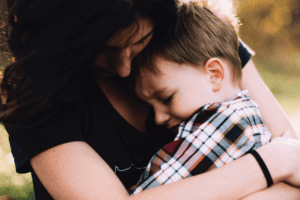
This post is the third in our series on pandemic emergency planning for families of kids with disabilities. Read part 1: Why is this so hard? and part 2: Who will take care of my child if I get sick?.
The final piece of making a pandemic emergency plan for your family is writing down what your back-up caregivers will need to know to keep your kid(s) healthy, safe, and calm. We’ve made some templates that you can download and fill out for your caregivers. [Download the template for the first part of your plan – choosing a caregiver]
Start with the medical information, including info about your child’s special needs.
First, get the easier things out of the way: immunization records, contact info for your pediatrician and specialists, and insurance information. You can do this in your sleep! Use this template to keep all of this information organized.
Now onto the hard stuff. What specialized care does your child need, and what resources can your caregiver use if they need guidance? If your child has Type 1 Diabetes, you may want to include the 24-hour endocrinology nursing line at the children’s hospital. If your child is Deaf and your caregiver doesn’t sign, it might be helpful to make notes about how well your child can communicate in writing and include contact information for a trusted Deaf or signing adult.
If your child has any specialized medical equipment or communication devices, think about what your caretaker needs to know. How much can your child teach them? Is there a website or a phone number they can call if the equipment isn’t working properly or if they have questions?
Finally, don’t forget your animals! If your child has a service animal or a beloved pet that will stay with them, make sure your caregiver knows how to take care of the animal, how to reach the vet, and where to find the license if your pet is a service animal.
If your child is medically complex, it may be helpful to use this Emergency Information form for Children with Special Health Care Needs in addition to our template.
Now think about what your child needs to stay calm and feel secure.
Your child is likely to feel scared in this situation and may not be at their best. When we’re scared, we want things that comfort us: people who understand our words and our emotions. Clothes and objects that feel good. Familiar food. Routines we understand. This last piece of your pandemic emergency plan is about making sure your back-up caregiver knows how to help your child.
We can’t ignore the fact that our kids (and adults!) often show stress through their behavior. What seems like “acting up” is usually a way to communicate their needs. We can tell that when they run out the room and hide, or have a meltdown, we have to tend to their needs. Maybe they need quiet time in their dark bed sheet fort, or deep hugs, or a few minutes outside hitting a punching bag. Make sure to explain to your back-up caregiver what your child’s behaviors may mean and how to respond to them.
Some things you may want to share with your back-up caregiver:
-
Communication cards you use with your non-verbal child
-
A social story about what is happening and why
-
Contact information for your child’s teacher or other trusted adults
-
A snapshot of your child’s daily schedule: zoom classes, exercise, playtime, bedtime routines, and so on
-
A list of things that help your child feel calm: favorite stuffed animals, cuddling with the dog, sensory management strategies like heavy pressure or jumping on a trampoline, a hot shower, music, reading together, or the phone number for their closest friend
-
A list of favorite foods, including the brands of pre-packaged food, their favorite pizza place, or even a simple recipe for how you make chicken
-
A behavior plan that helps the caregiver understand how your child reacts to stress and what to do
Download and complete this template to capture all of this.
If you will be separated from your child, it may also help to have a communication routine for you to stay in touch if you are well enough. If it’s possible, plan a regular schedule of how and when you will talk to your child. It will help you stay connected to each other and know what to expect.
Don’t forget to take of yourself during this emergency! As part of your plan, write down a few things you can do to stay calm and grounded. It may be a few minutes of meditation, calling a friend to talk, or having a picture or video of your family handy.
You did it! Get yourself some ice cream. You’ve earned it.
You just accomplished something really difficult. We hope you will never need to use it, but the plan you just made is an act of love for your child. Stay safe!



